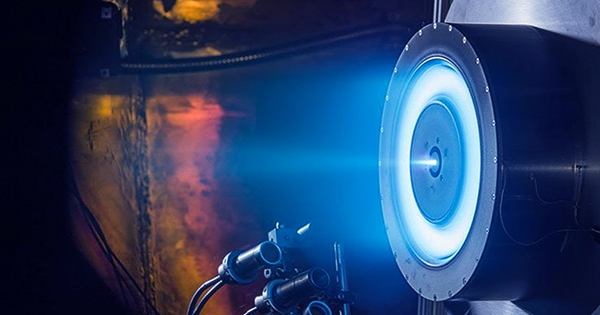The successful demonstration of an iodine electric thruster in space means that cheaper, more powerful ways to move satellites in orbit and spacecraft exploring other worlds are on the horizon.
With the recent explosion of the Cosmos 1408 spacecraft, low Earth orbit has become a much more perilous area. Improved escape capability would be greatly welcomed.
Because friction and air resistance do not affect Newtonian action and response in space, moving a spaceship is as simple as firing a propellant in the opposite direction. Electric propulsion thrusters are more efficient than chemically propelled thrusters are and are becoming more common. Less-than-ideal propellants have impeded them, though.
For the past 50 years, iodine has been recommended as a better propellant than the currently used xenon and krypton; however, there have been several roadblocks. Nature has published an article on ThrustMe’s successful first demonstration of an iodine thruster in space. A year earlier, a CubeSat satellite weighing 20 kilograms (44 pounds) raised its height by 200-400 meters (656-1,312 feet) on each of 11 firings.
Thrusters like these are a long way from being able to provide the rapid bursts of power needed to launch a vehicle from a planet or huge moon. They are, however, more efficient than rockets for making modifications once in orbit, and they have utilized for moderate speed builds-ups, such as on asteroid prospecting missions.
Propellant is not the same as fuel; any ionized material might be theoretically used, but most compounds have issues of some sort. Because of its low ionization energy, xenon is now the most used propellant. However, it is costly on Earth, nearly hard to get elsewhere in the Solar System, and must keep in high-pressure tanks that must launch due to their weight. Despite what Superman may claim, Krypton is less expensive, but it also has some of the same issues.
Iodine has lower ionization energy than xenon, but it may be kept as a solid and converted to gas with only a little amount of heat. Many individuals have recognized iodine’s potential and researched its application on Earth. Unfortunately, iodine is very reactive, posing a risk to metal components in a thruster, and when held as a solid, it tends to break apart in ways that might obstruct its flow.
ThrustMe has previously proved that storing iodine in an aluminum oxide ceramic block prior to heating was feasible on Earth. Nature research demonstrates that the concept also works in space, where it matters.
The iodine was heated and then ionized using a radio-frequency inductive antenna, which expedited a chain reaction and produced ions, which then accelerated with an 800-1,300 Volt electric field. The resultant propellant outperforms xenon in terms of power to weight.
The fact that satellites are becoming increasingly numerous in the early evening under a dark sky verifies this. According to an editorial accompanying the publication, just 39 new satellites launched in 2011, but by 2020, the number had risen to 1,202. Those satellites will require the ability to alter their orbits affordably in order to avoid colliding, which ThrustMe’s iodine engine may deliver.
ThrustMe recognises that xenon still has a faster start time, which is useful in an emergency. Electric thrusters while inexpensive and efficient are nevertheless far less powerful than traditional rockets, posing a challenge for crewed missions that require large vehicles and cannot afford to wait. Nonetheless, there is still optimism that this technology will be used to send humans to Mars.














